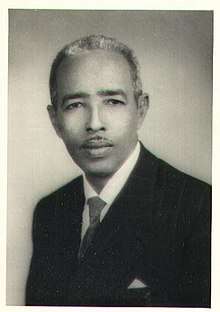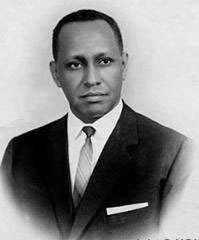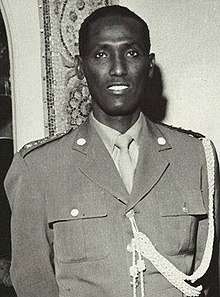Hawiye
The Hawiye (Somali: Hawiye, Arabic: بنو هوية) is a major Somali clan. Members of the clan traditionally inhabit central and southern Somalia, Somali Region and the North Eastern Province (currently administered by Ethiopia and Kenya, respectively). Like many Somalis, Hawiye members trace their paternal ancestry to Irir, the first son of Samaale.
| Regions with significant populations | |
|---|---|
| Languages | |
| Somali | |
| Religion | |
| Islam (Sunni, Sufism) | |
| Related ethnic groups | |
| Dir, Darod, Isaaq, Rahanweyn, other Somalis |

The Hawiye have produced many prominent Somali figures with the first President, Prime Minister, and the father of the Somali Military all hailing from the Hawiye.
Overview
According to many documented sources and historians, the patriarch Samaale arrived in northern Somalia from Yemen during the 9th century and subsequently founded the eponymous Samaale clan.[1] Two of the major clans the Hawiye and Dir trace descent from Irir the son of Samaale, who in turn traces his geneological traditions to Arabian Quraysh Banu Hashim origins through Aqiil the son of Abu Talib ibn Abd al-Muttalib, who was cousin of the Prophet Muhammed.[2][3][4][5][6][7]
Distribution
Due to ancient pastoralist migrations and population movements across the Somali peninsula in search of water wells and grazing land over a period of thousand years, Hawiye clans can today can be found inhabiting an area stretching from the fertile lands of southern Somalia between Barawa and Kismayo, to the regions surrounding Mogadishu and Warsheikh in the hinterland, west to the modern city of Beledweyne in the Hiran region, and north to the ancient port town of Hobyo in the arid central Mudug region.[8]
Role and Influence in Somalia


The Hawiye have historically played an important role in Somalia. The majority of Somalia's founding fathers hailed from the Hawiye. The first President of Somalia, Prime minister, and the father of the Somali Military were all Hawiye. Aden Adde the first president was Udejeen. The first prime minister Abdullahi Issa was Habar Gidir. The father of Somali military Daud Abdulle Hirsi was Abgaal. Since then the Hawiye have produced four more presidents and three more prime ministers. The Hawiye's role in Somalia is not limited to only political affairs. They are also prominent in other important fields in Somali society. The clan also has prominent members within the Somali business and media communities. For example, Abdirahman Yabarow, the editor-in-chief of VOA Somali is also kin. Yusuf Garaad Omar who was the chairman of BBC Somali for over a decade and helped pioneer its rise during his tenure is also a member. Magool and Hasan Adan Samatar who are among some of the most famous Somali musicians of all time also hail from this clan. The Hawiye also play an important role in business. For instance the head of the Somali airline company Jubba Airways and Hormud Telecom are also members. Currently the Hawiye play a large role primarily in the Somali regions of Galmudug, Hirshabelle, South West State and Banadir (Mogadishu) but also Somalia as a whole.
History
Hawiye along with some Samaale sub-clans migrated to central and southern Somalia in the 1st century AD to populate the Horn of Africa. They established farmlands in the fertile plain lands of southern Somalia and also established flourishing harbor ports in south and central Somalia.[9]
The first written reference to the Hawiye dates back to a 12th-century document by the Arab geographer, Ibn Sa'id, who described Merca at the time as the "capital of Hawiye country". The 12th century cartographer Muhammad al-Idrisi may have referred to the Hawiye as well, as he called Merca the region of the "Hadiye", which Herbert S. Lewis believes is a scribal error for "Hawiye", as do Guilliani, Schleicher and Cerulli.[10]
The Hawiye spearheaded the Ajuran Empire control in the 13th century that governed much of southern Somalia and eastern Ethiopia, with its domain extending from Hobyo in the north, to Qelafo in the west, to Kismayo in the south.[11][12]:102
At the end of the 17th century, the Ajuran Empire was on its decline due to wars against the Portuguese and the Ethiopians which allowed the Hiraab subclan to usurp the Ajuran rulers and ever since this first revolt against the Ajuran other groups would follow in the rebellion which would eventually bring down Ajuran rule of the inter-riverine region.[13]
Lee Cassanelli in his book, The Shaping of Somali society, provides a historical picture of the Hiraab Immate. He writes:
"According to local oral tradition, the Hiraab imamate was a powerful alliance of closely related groups who shared a common lineage under the Gorgaarte clan divisions. It successfully revolted against the Ajuran Empire and established an independent rule for at least two centuries from the seventeen hundreds and onwards.[12]
The alliance involved the army leaders and advisors of the Habar Gidir and Duduble, a Fiqhi/Qadi of Sheekhaal, and the Imam was reserved for the Mudulood branch who is believed to have been the first born. Once established, the Imamate ruled the territories from the Shabeelle valley, the Benaadir provinces, the Mareeg areas all the way to the arid lands of Mudug, whilst the ancient port of Hobyo emerged as the commercial center and Mogadishu being its capital for the newly established Hiraab Imamate in the late 17th century.[12]
Hobyo served as a prosperous commercial centre for the Imamate. The agricultural centres of Eldher and Harardhere included the production of sorghum and beans, supplementing with herds of camels, cattle, goats and sheep. Livestock, hides and skin, whilst the aromatic woods and raisins were the primary exports as rice, other foodstuffs and clothes were imported. Merchants looking for exotic goods came to Hobyo to buy textiles, precious metals and pearls. The commercial goods harvested along the Shabelle river were brought to Hobyo for trade. Also, the increasing importance and rapid settlement of more southernly cities such as Mogadishu further boosted the prosperity of Hobyo, as more and more ships made their way down the Somali coast and stopped in Hobyo to trade and replenish their supplies.[12]
The economy of the Hawiye in the interior includes the predominant nomadic pastoralism, and to some extent, cultivation within agricultural settlements in the riverine area, as well as mercantile commerce along the urban coast. At various points throughout history, trade of modern and ancient commodities by the Hawiye through maritime routes included cattle skin, slaves, ivory and ambergris.[14][12]
Soon afterwards, the entire region was snapped up by the fascists Italians and it led to the birth of a Modern Somalia. However, the Hiraab hereditary leadership has remained intact up to this day and enjoys a dominant influence in national Somali affairs."[12]
Clan tree
Ali Jimale Ahmed outlines the Hawiye clan genealogical tree in The Invention of Somalia:[15]
- Samaale
- Irir
- Hawiye
- Karanle
- Kaariye Karanle
- Gidir Karanle
- Sixaawle Karanle
- Murusade Karanle
- Sabti
- Foorculus
- Gugundhabe
- Gorgate
- Hiraab
- Mudulood
- Wacdaan
- Moobleen
- Ujajeen
- Abgaal
- Harti
- Angonyar
- Warsangeli
- Abokor
- Wabudhan
- Da'oud
- Reer Mattan
- Mohamed Muse
- Wa'esli
- Harti
- Duduble
- Habar Gidir
- Sacad
- Saleebaan
- Cayr
- Saruur
- Mudulood
- Silcis
- Wadalaan
- Hiraab
- Jambeelle
- Hintire
- Xaskul
- Raarane
- Karanle
- Hawiye
- Irir
Notable Hawiye figures
Politicians
- Abdiqasim Salad Hassan, President of Somalia, 2000–2004
- Abdullahi Issa, Prime Minister of Somalia, 1954–1960
- Aden Abdullah Osman Daar, President of Somalia, 1960–67
- Ali Mahdi Muhammad, President of Somalia, 1991–1995
- Ali Mohammed Ghedi, Prime Minister of Somalia, 2004–2007
- Haji Farah Ali Omar, minister for Economic Affairs of Somalia,1956–1960
- Hassan Sheikh Mohamud, Former President of Somalia
- Mohamed Farrah Aidid, President of Somalia 1995-1996
- Nur Hassan Hussein, Prime Minister of Somalia, 2007–2009
- Sharif Ahmed, President of Somalia, 2009-2012
- Abdirahman Janaqow, Somali leader, deputy chairman of the Islamic Courts Union of Somalia (ICU), Minister of Justice
- Abdullahi Ahmed Addow, former Somalia Ambassador to the United States (1970–80)
- Abdi Mude Ibrahim, Current Lafey Constituency Kenyan Member of National Assembly/Parliament, 2017-2022 [16]
- Abukar Umar Adani, Islamist, businessman who used to control the El-ma`an beach area which served as Mogadishu's port since the closure in 1995 of the city's main port
- Bashir Raghe Shiiraar, secular faction leader; member of the US-backed Alliance for Peace and the Fight Against International Terrorism
- Shaaban Ali Issack , Former Kenyan Member of National Assembly/Parliament, Assistant Minister for Urban Development 1995-2007 [17]
- Hassan Mohamed Hussein Mungab, Mayor of Mogadishu
- Mohamed Abdi Hassan, entrepreneur and faction leader
- Mohamed Afrah Qanyare, politician who was based to the south of Mogadishu and member of TFG parliament
- Mohamed Nur, former Mayor of Mogadishu
- Mohamed Moallim Hassan, politician who served as minister of fishery and marine resources of Somalia, 2010- 2011
- Mohamed Hussein Ali, Former Kenyan Member of National Assembly/Parliament, 2007-2013
- Omar Maalim, Current Mandera Town Constituency Kenyan Member of National Assembly/Parliament, 2017-2022 [18]
Military personnel
- Ahmed Maxamed Xasan, Lieutenant colonel who defused Mig-17 jet fighter bombs
- Daud Abdulle Hirsi, Commander-in-chief of the Somali national forces, 1960–67
- Hassan Dahir Aweys, leader of Islamist revolution in Somalia, 2006–09
- Hussein Kulmiye Afrah, vice-president of Somalia under the Siad Barre regime
- Mohamed Farrah Aidid, Chairman of the United Somali Congress, 1991–1994
- Muuse Suudi Yalahow, politician who served as Trade Minister in the Transitional Federal Government
- Salaad Gabeyre Kediye, father of the 1969 revolution
Leading intellectuals
- Abdi Mohamed Ulusso, 2003 presidential candidate
- Abdirahman Yabarow, Editor-in-Chief of the VOA Somali Service
- Abdulkadir Yahya Ali, peace activist, co-director and founder of the Center for Research and Dialogue 1957-2005 [19]
- Abukar Umar Adani, businessman who operates the Elman port services
- Ali Jimale, educator at the City University of New York
- Ali Sheikh Ahmed, dual president of Mogadishu University and Al-Islaah
- Elman Ali Ahmed, entrepreneur and social activist
- Hilowle Imam Omar, co-chairman of the reconciliation program 1995-2000
- Hussein Ali Shido, founding member of the United Somali Congress
- Hussein Sheikh Ahmed Kaddare, author of the Kaddariya script, 1952
- Ibrahim Hassan Addou, former professor of Washington University. Foreign Minister of the Union of Islamic courts in 2006
- Omar Iman Abubakar, professor and researcher in Hadith Sunna, Chairman of Hisbi Islam[20][21]
Traditional elders and religious leaders
- Sheikh Ali Dhere, founder of the first Islamic Court in Mogadishu
Music and literature
- Abdi Bashiir Indhobuur, poet and composer, writer of several patriotic songs
- Abdulle Geedannaar, poet
- Hasan Adan Samatar, musician
- K'naan, Somali-Canadian poet, rapper and musician
- Magool (Halima Khalif Omar), musician
- Hanad Hassan Omar Founder if Mali Castle Empire and Jeshka record label
Political factions and organizations
- Alliance for the Restoration of Peace and Counter-Terrorism, (ARPCT) a Somali alliance created by various faction leaders and entrepreneurs
- Hizbul Shabaab, the Youth Movement wing of the ICU before ceding the organisation to Aden Hashi Farah "Eyrow"
- Islamic Courts Union (ICU), a rival administration to the Transitional Federal Government.
- Juba Valley Alliance (JVA), primary opponent of the Somali Patriotic Movement
- Somali National Alliance (SNA) formed by Mohamed Farrah Aidid
- Somali Salvation Army (SSA), the Ali Mahdi Muhammad branch of the United Somali Congress
- United Somali Congress (USC), formed in 1987, played a key role in the ouster of the dictatorship
See also
References
- Lewis, I. M.; Said Samatar (1999). A Pastoral Democracy: A Study of Pastoralism and Politics Among the Northern Somali of the Horn of Africa. LIT Verlag Berlin-Hamburg-Münster. pp. 11–13. ISBN 3-8258-3084-5.
- Lewis, I. M. (1999-01-01). A Pastoral Democracy: A Study of Pastoralism and Politics Among the Northern Somali of the Horn of Africa. James Currey Publishers. p. 12. ISBN 9780852552803.
- Ahmed, Akbar (2013-02-27). The Thistle and the Drone: How America's War on Terror Became a Global War on Tribal Islam. Brookings Institution Press. ISBN 9780815723790.
- Mukhtar, Mohamed Haji (2003-02-25). Historical Dictionary of Somalia. Scarecrow Press. ISBN 9780810866041.
- Ng'ang'a, Wangũhũ (2006). Kenya's ethnic communities: foundation of the nation. Gatũndũ Publishers. ISBN 9789966975706.
- Noyoo, Ndangwa (2010-01-30). Social Policy and Human Development in Zambia. Adonis & Abbey Publishers Ltd. ISBN 9781912234936.
- Lewis, I. M.; Samatar, Said S. (1999). A Pastoral Democracy: A Study of Pastoralism and Politics Among the Northern Somali of the Horn of Africa. LIT Verlag Münster. ISBN 9783825830847.
- The Somali, Afar and Saho groups in the Horn of Africa by I.M Lewis
- Abdullahi, Abdurahman (18 September 2017). Making Sense of Somali History: Volume 1. Adonis and Abbey Publishers. pp. 43–. ISBN 978-1-909112-79-7.
- Herbert S. Lewis, "The Origins of the Galla and Somali", in The Journal of African History. Cambridge University Press, 1966, pp 27–30.
- Lee V. Cassanelli, The shaping of Somali society: reconstructing the history of a pastoral people, 1600-1900, (University of Pennsylvania Press: 1982), p.102.
- Lee V. Cassanelli (1982). The Shaping of Somali Society: Reconstructing the History of a Pastoral People, 1600 to 1900. University of Pennsylvania Press. ISBN 978-0-8122-7832-3.
- Lee V. Cassanelli, Towns and Trading centres in Somalia: A Nomadic perspective, Philadelphia, 1980, pp. 8-9.
- Kenya's past; an introduction to historical method in Africa page by Thomas T. Spear
- Ali Jimale Ahmed (1995). The Invention of Somalia. Lawrenceville, NJ: Red Sea. p. 123. ISBN 0-932415-98-9.
- "Abdi Mude Ibrahim".
- "Shaaban Isaack Biography, Family and Contacts". 23 June 2016.
- "Omar Mohamed Maalim Hassan".
- "CRD Somalia". Center for Research and Dialogue. 2005-07-12. Retrieved 2010-10-12.
- "Archived copy". Archived from the original on 2009-06-11. Retrieved 2012-09-24.CS1 maint: archived copy as title (link)
- "Somalia: Islamic Party Insurgents Declare War On New Govt". 8 February 2009. Retrieved 6 April 2018 – via AllAfrica.